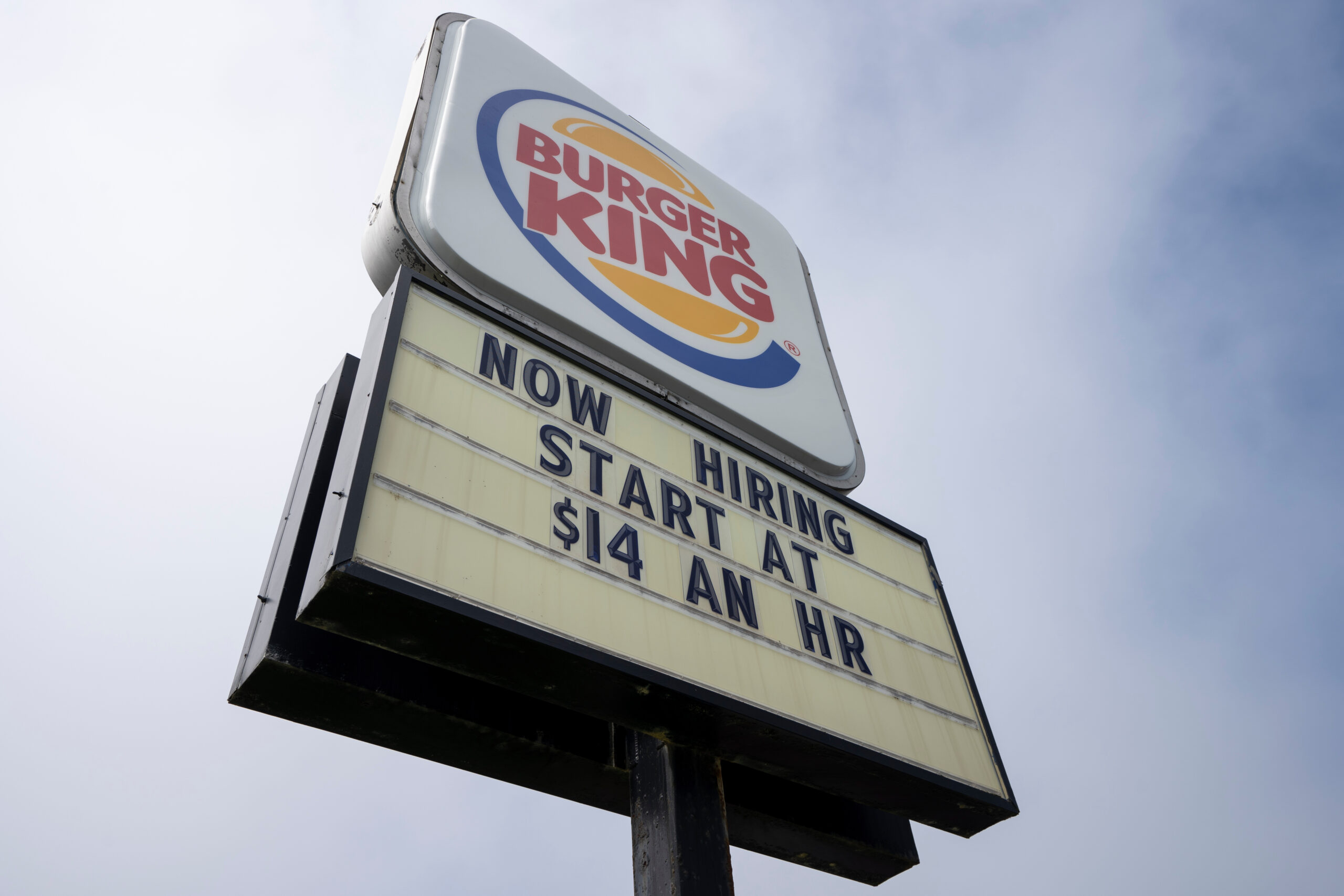Wages
Wages

Wages
Introduction
Wages – too low and too unequal – are at the heart of key public policy debates and social movements from the Fight for Fifteen to rising wage inequality. The Shift Project collects detailed information to define what we know about this crucial aspect of job quality. Shift data break new ground by linking employers and employees, providing detailed, firm-level information on what workers earn.
The Company Wage Tracker
Our data allow for key comparisons across 125 of the largest service-sector employers in the United States. We provide a company-by-company breakdown that shows what workers earn at some of the country’s largest and most profitable firms.
In collaboration with the Economic Policy Institute, we released the Company Wage Tracker in April 2022. The tracker is an interactive data tool that reveals how wages are distributed for hourly workers at 66 large service-sector firms. This tool lays bare just how low wages are throughout the service sector, but also the degree to which firms vary both between and within sectors in what they pay. Low wages are most prevalent in the food service and hospitality sectors, where 63% of workers earn below $15/hr. But, even within this sector, there is variation. In-N-Out Burger is a bright spot, with only 9% workers earning below $15/hr, as compared with 89% of workers earning under $15/hr at McDonalds. These differences across firms illustrate that low wages are not inevitable.
Figure 1. Share of Workers Earning Less Than $15/hr in In-N-Out Burger and McDonald’s


“The Company Wage Tracker: Estimates of Wages at 66 Large Service-Sector Employers”. 2022. The Shift Project and Economic Policy Institute.
Wage Patterns for Key Populations
The Shift Project’s wage data also reveals how workers’ wages fare across key sub-populations of workers in the service-sector.
Young Workers
A series of Shift Project briefs demonstrate the variability of hourly wages across young service-sector workers.
One brief (2021) reveals that a substantial amount of these young service-sector workers earn below a living wage (defined as $15/hr for a one-person household in high-cost states), with those at the 10th percentile of the wage distribution making around $8.25/hr and those at the 90th percentile earning nearly $14.65/hr. This leaves young service-sector workers vulnerable to economic insecurity.
The graphs below show how measures of economic insecurity vary by hourly wage for these young workers.
Figure 2. Wages and Economic Insecurity
“Early Career Workers in the Service Sector”. 2021. The Shift Project Research Brief.
Another brief (2023) unveils how, during the “Great Resignation” (2021-2022), many young workers left their service-sector jobs to upgrade job-quality aspects, like wages. For example, young workers who switchedfast food workers face the lowest wages and least unpredictable to a new job during this time period increased their wages by more than $2.50/hr while those who remained at their job only did so by around $1.70/hr.
Figure 3. Changes in Hourly Wages as a Function of Job Leaving
California Fast Food Workers
A Shift Project brief (2022) illustrated the importance of California’s Fast Food Accountability and Standards Recovery Act by showing that fast food workers faced the lowest wages and least predictable schedules among service workers in California.
Table 1. Average Hourly Wage and Weekly Hours for California Fast Food vs. Other Service Sector
“Low Pay, Less Predictability: Fast Food Jobs in California”. 2022. The Shift Project Research Brief.
Gig Workers
In addition to studying service-sector workers directly employed by companies (W-2 employees), the Shift Project has also collected new data on gig workers, who are typically classified as independent contractors. A collaboration with the Economic Policy Institute, “National survey of gig workers paints a picture of poor working conditions, low pay”, revealed that the independent contractor label masked significant levels of sub-minimum wages for gig workers – with 14% reporting hourly wages of less than the federal minimum.
Table 2. Hourly Wage Distribution of Gig Workers and W-2 Service-sector Workers, May 2020
“National Survey of Gig Workers Paints a Picture of Poor Working Conditions, Low Pay”. 2022. The Shift Project and Economic Policy Institute.
Wage Inequality
It’s no secret that the service sector is home to some of the most precarious jobs. The over-representation of women, mothers, and trans/non-binary people in this sector, is an important source of broader wage inequality for these groups.
The Shift Project data also shows that workers in these groups earn lower wages within the service sector, compared to their co-workers.
Gender Wage Gaps
Recent Shift estimations find the (unadjusted) gender wage gap to be nearly $2/hr (equivalent to 14% of the average hourly wage). The figure below shows that the average wage at a firm declines as the share of female workers increases.
Figure 4. Bivariate Relationship Between Percent Female and Average Hourly Wages at 125 Companies.
Carmen Brick, Daniel Schneider, and Kristen Harknett. 2023. “The Gender Wage Gap, Between-Firm Inequality, and Devaluation: Testing a New Hypothesis in the Service Sector.” Work and Occupations 50(4): 463-587.
Motherhood Wage Gaps
Figure 5 illustrates differences in hourly wages among service-sector workers by gender and parental status, highlighting either a motherhood penalty or a fatherhood premium. Fathers earn the highest wages at $19.00 per hour, followed by childless men at $17.50. For women, the pattern is reversed: childless women earn $16.40, while mothers earn just $15.40 per hour. The extent of the motherhood disadvantage is clear—mothers earn $3.60 less per hour than fathers, amounting to a 19% wage gap.
Figure 5. Predicted Hourly Wage Levels by Gender and Parental Status.
Charlotte O’Herron, Daniel Schneider, and Kristen Harknett. (2024). “Between-Firm Sorting and Parenthood Wage Gaps in the US Service Sector.” Journal of Marriage and Family, 1–27.
Trans/Non-Binary Wage Gaps
Trans and non-binary service-sector workers face worse working conditions than their cisgender co-workers, including on wages. Where cisgender men make an estimated $13.81 per hour, transgender and nonbinary workers are making between $12.75 (trans women) and $13.57 (trans men).
Cis male workers have the highest hourly wages at $13.81. In comparison, transgender women earn nearly $1.25/hour less in similar jobs.
Figure 6. Predicted Means and Probabilities for Hourly Wage by Gender Identity Categories
Danya Lagos, Rebecca Wolfe, and Daniel Schneider. “Do Transgender and Non-Binary Workers in the Retail and Service Sectors Have Lower Quality Jobs than their Cisgender Counterparts?” (Working Paper)
Between-Firm Segregation
One crucial but often overlooked source of these wage gaps is between-firm segregation, or the unequal sorting of women, mothers, and trans/non-binary folks into lower paying firms.
This sorting isn’t just because mothers, for instance, look for jobs that might pay less in exchange for more flexible schedules or better benefits. It’s also not just that these low-paying firms are also less profitable. Instead, this kind of between-firm segregation appears to be the result of discrimination at the time of hiring.
However, between-firm sorting doesn’t explain all of wage gaps. Even among similar workers at the very same firms, marginalized workers often still earn less than their co-workers.
Figure 7. Within- and Between-Firm Contributions to Parenting Wage Gaps by Gender





